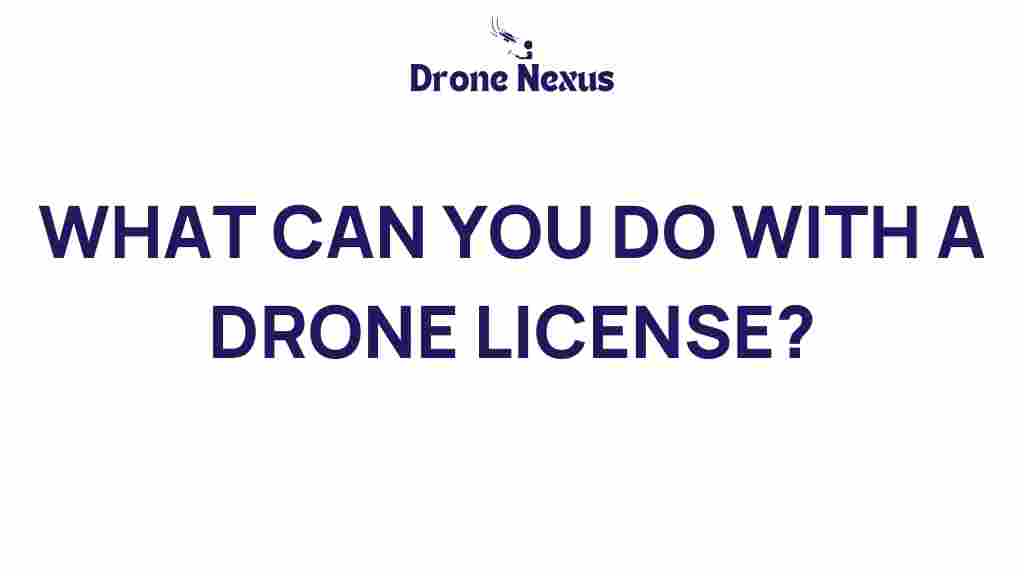Unlocking the Skies: What You Can Do with a Drone License
The world of drones has evolved significantly over the past decade, transforming from a niche hobby into a booming industry. With this growth comes the necessity of a drone license. Whether you’re considering flying drones for personal enjoyment or as part of a professional career, obtaining a drone license opens up a myriad of opportunities. In this article, we’ll explore what you can do with a drone license, the benefits it provides, and how to navigate the licensing process effectively.
The Importance of a Drone License
A drone license is essential for anyone wishing to operate drones legally, especially for commercial purposes. Understanding the regulations and requirements set by aviation authorities is crucial to ensure safe and responsible flying. Here are some key reasons why having a drone license is important:
- Legal Compliance: Operating a drone without a license can lead to hefty fines and legal issues.
- Insurance Benefits: Many insurance policies require a drone license for coverage.
- Enhanced Skills: Training for a drone license helps you develop crucial flying skills and knowledge.
- Business Opportunities: A valid drone license opens up numerous avenues for professional work.
Step-by-Step Process to Obtain a Drone License
Getting your drone license might seem daunting, but it can be broken down into manageable steps. Here’s a guide to help you through the process:
Step 1: Research Your Local Regulations
Before diving into the licensing process, it’s vital to understand the regulations specific to your country or region. In the United States, the Federal Aviation Administration (FAA) governs drone operations. For other countries, check with relevant aviation authorities. Make sure to familiarize yourself with:
- Weight classifications of drones
- Flight restrictions in specific areas
- Registration requirements
Step 2: Choose the Right License
Depending on your intended use, you will need to select the appropriate type of drone license. In the U.S., for instance, the FAA offers two primary types:
- Part 107 License: Required for commercial drone pilots.
- Recreational License: For hobbyists flying drones without commercial intent.
Step 3: Complete Required Training
Training is crucial to preparing for the licensing exam. You can choose to enroll in a formal course or study independently. Many online platforms offer resources tailored for drone pilots. Key topics to focus on include:
- Aerodynamics
- Airspace classifications
- Weather effects on flight
- Emergency procedures
Step 4: Pass the Knowledge Test
Once you’ve completed your training, the next step is to take the knowledge test. This test typically covers:
- Regulations
- Flight operations
- Emergency procedures
In the U.S., the FAA provides a designated testing center where you can take the exam. A passing score is necessary to obtain your drone license.
Step 5: Obtain Your License
After successfully passing the test, you will receive your drone license. Make sure to keep it updated, as licenses may require renewal after a set period. Check your local regulations for details.
What You Can Do with a Drone License
With your drone license in hand, the sky is literally the limit. Here are some of the most popular applications for licensed drone pilots:
1. Aerial Photography and Videography
One of the most sought-after uses of a drone is capturing stunning aerial imagery. This can include:
- Weddings and events
- Real estate listings
- Documenting outdoor adventures
2. Surveying and Mapping
Many industries, including construction and agriculture, rely on drones for surveying land and creating detailed maps. Drones can provide:
- 3D mapping services
- Topographic surveys
- Crop monitoring
3. Infrastructure Inspection
Drones are increasingly used to inspect critical infrastructure, such as:
- Bridges
- Power lines
- Wind turbines
This application is not only cost-effective but also safer than traditional inspection methods.
4. Emergency Services and Public Safety
Many emergency services have begun utilizing drones for tasks such as:
- Search and rescue operations
- Disaster assessment
- Firefighting support
5. Delivery Services
With advancements in drone technology, companies are exploring drone delivery services for products ranging from food to medical supplies. Obtaining a drone license is a crucial step for those looking to enter this innovative field.
Troubleshooting Tips for New Drone Pilots
- Battery Problems: Always check the battery level before flights and ensure it’s fully charged.
- Signal Loss: Maintain line-of-sight with your drone to avoid losing signal. Use a spotter if necessary.
- Weather Conditions: Avoid flying in adverse weather conditions such as strong winds or rain.
Conclusion
Obtaining a drone license is a gateway to exciting opportunities in various fields. From aerial photography to emergency services, the applications of drones are vast and growing. By following the necessary steps to obtain your license, you’ll not only comply with regulations but also enhance your skills and open new doors for your career.
For more information on drone regulations and licensing, check out the FAA website. To connect with other drone enthusiasts, consider joining local clubs or online forums.
Now is the perfect time to take to the skies! With your drone license, you can explore the endless possibilities that await you.
This article is in the category Technology and created by DroneNexus Team
